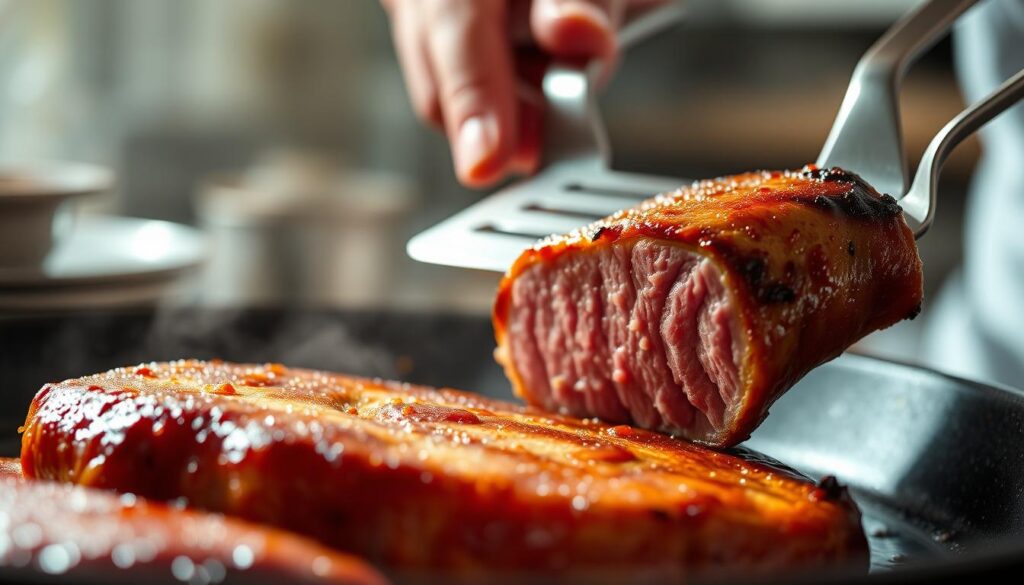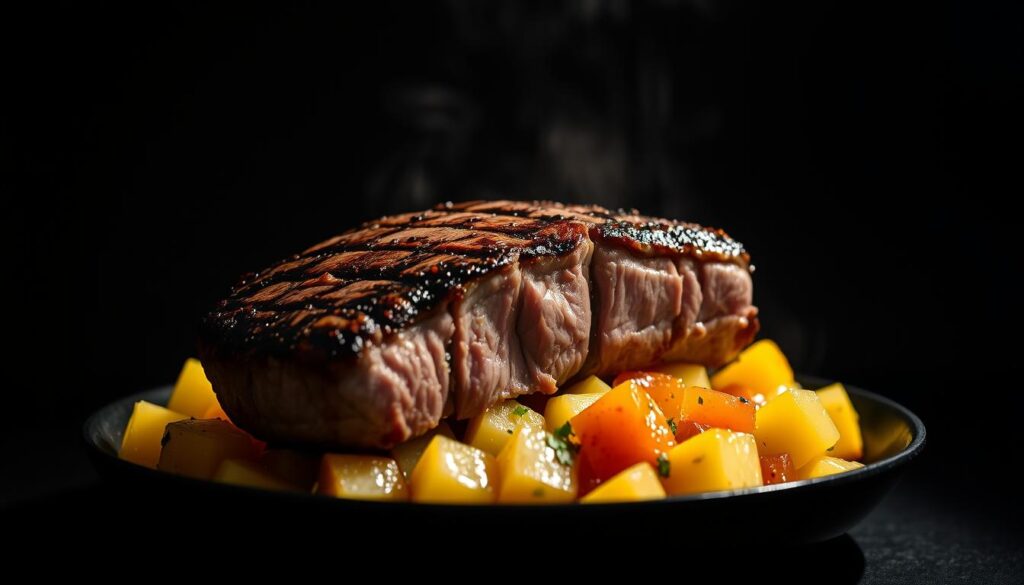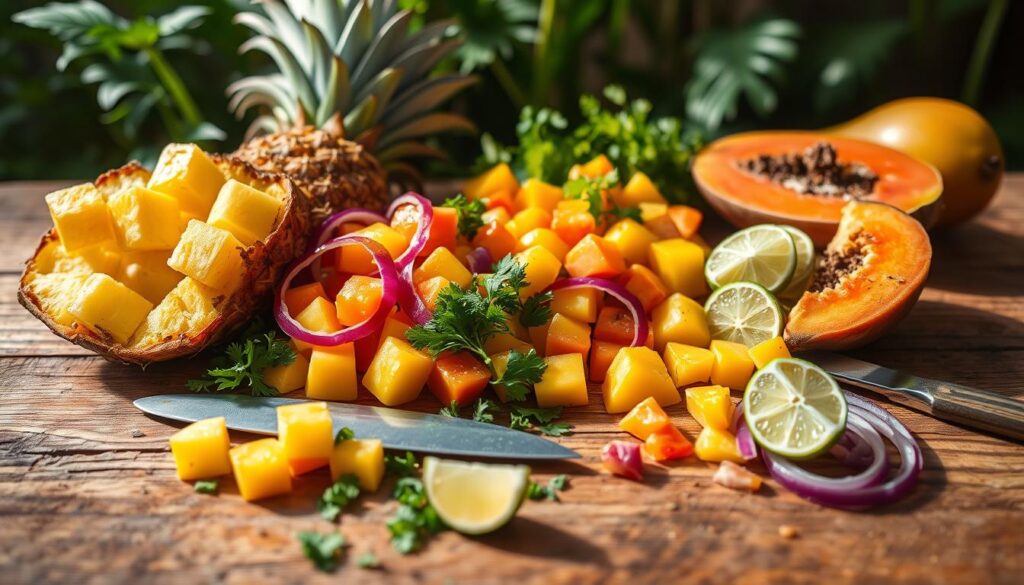
Summer evenings bring to mind culinary adventures that turn simple meals into unforgettable moments. My love for making restaurant-quality beef tenderloin began with a special dinner. It changed how I see summer cooking. This dish, pan seared tenderloin recipe paired with pineapple mango salsa , is more than just a recipe. It’s a celebration of flavors that mix savory meat with fresh, tropical notes.
Cooking is not just about following a recipe; it’s about making moments of joy. Each piece of beef tenderloin seared to perfection tells a story of skill, passion, and love for food. I’m eager to share my surefire method. It will help you improve your cooking and wow your guests with a dish that looks and tastes like it’s from a pro kitchen.
- Understanding the Art of Pan Searing Beef Tenderloin
- Pan Seared Tenderloin Recipe Paired with Pineapple Mango Salsa
- Crafting the Perfect Tropical Fruit Salsa
- Essential Marinade and Seasoning Guidelines
- Step-by-Step Cooking Instructions for Restaurant-Quality Results
- Wine Pairing and Serving Suggestions
- Conclusion
- FAQ
Understanding the Art of Pan Searing Beef Tenderloin
Learning to sear beef tenderloin is key to making it a fine dining dish. I’ll show you how to achieve this in your kitchen.

Getting a restaurant-quality sear is more than just cooking meat in a hot pan. It’s about precision, technique, and knowing how to cook this special cut of beef.
Essential Equipment for Perfect Searing
The right tools are the start of your searing success. Here are my top picks:
- Cast iron skillet (preferably well-seasoned)
- High-quality meat thermometer
- Tongs for precise meat handling
- Heavy-bottomed stainless steel pan
Temperature Control Techniques
Temperature is key in searing. Follow these heat management tips:
| Meat Temperature | Pan Heat Level | Recommended Technique |
|---|---|---|
| Room Temperature | Medium-High | Perfect Sear Preparation |
| Cold Center | Low-Medium | Gradual Heating |
| Even Temperature | High | Quick Searing |
Choosing the Right Cut of Tenderloin
Not all beef tenderloins are the same. For top-notch dishes, look for these traits:
- Deep red color with minimal connective tissue
- Uniform thickness for consistent cooking
- USDA Prime or Choice grade preferred
- Minimal surface moisture
By mastering these searing techniques, you’ll take your home cooking to the next level. You’ll make meals that impress every time.
Pan Seared Tenderloin Recipe Paired with Pineapple Mango Salsa
Making a gourmet meal with meat and fruit can turn a simple dinner into a special event. My pan seared tenderloin with pineapple mango salsa is a perfect mix of savory and sweet. It will wow even the pickiest eaters.

Ingredients for Tenderloin
- 2 beef tenderloin steaks (6-8 oz each)
- 2 tablespoons olive oil
- Salt and freshly ground black pepper
- 2 tablespoons unsalted butter
- 2 garlic cloves, minced
Ingredients for Pineapple Mango Salsa
- 1 cup fresh pineapple, diced
- 1 ripe mango, chopped
- 1/4 red onion, finely diced
- 1 jalapeño, seeded and minced
- Fresh cilantro, chopped
- Lime juice
Pro tip: The key to an exceptional meat and fruit pairing is selecting perfectly ripe fruits that complement the rich flavor of the tenderloin.
This pan seared tenderloin recipe is simple yet packed with flavor. The tropical salsa adds a burst of freshness. Together, they make a gourmet meal that’s both stunning and tasty.
Crafting the Perfect Tropical Fruit Salsa
Making a great tropical fruit salsa turns summer meals into a colorful feast. The right mix of flavors can make a simple dish unforgettable. It’s especially good with pan-seared tenderloin.

Let’s explore how to make a tasty tropical fruit salsa. It will delight your taste buds and impress your guests.
Selecting and Ripening Fruits
Picking the right fruits is key for a top-notch tropical fruit salsa. Here’s what to look for:
- Pineapples should have a golden-yellow color and smell sweet
- Mangoes should give a bit when pressed gently
- Steer clear of fruits with bruises or soft spots
Balancing Sweet and Spicy Elements
The secret to a fantastic salsa is mixing sweet and spicy flavors well. Here’s how I do it:
- Start with ripe tropical fruits for sweetness
- Add jalapeños or serrano peppers for spice
- Use fresh cilantro for a bright touch
Make-Ahead Tips for Fresh Salsa
Here are some tips for making your tropical fruit salsa ahead of time:
| Preparation Method | Storage Time | Best Practices |
|---|---|---|
| Chopped Ingredients | 4-6 hours | Store in airtight container |
| Mixed Salsa | 24 hours | Add cilantro just before serving |
By following these tips, you’ll make a tropical fruit salsa that adds excitement to your summer meals. It will also pair well with your pan-seared tenderloin.
Essential Marinade and Seasoning Guidelines
Creating the perfect beef tenderloin begins with mastering marinades and seasonings. The right mix of flavors can turn a simple cut into a gourmet delight.
When cooking beef tenderloin, aim for marinades that boost its natural taste without drowning it. The goal is to find the right balance and choose ingredients wisely.
- Choose acid-based marinades with citrus or vinegar to tenderize the meat
- Select herbs that complement beef’s robust flavor profile
- Limit marinating time to prevent breaking down meat texture
I prefer building layers of flavor in my marinades. Here’s a mix I often use:
| Ingredient Category | Suggested Components | Flavor Profile |
|---|---|---|
| Acids | Red wine vinegar, Balsamic | Tenderizing |
| Herbs | Rosemary, Thyme | Aromatic |
| Oils | Olive Oil, Avocado Oil | Moisture Retention |
For grilling, marinate beef tenderloin for 2-4 hours max. Longer times can make the meat too soft. We aim to add flavor without losing tenderness.
- Use fresh herbs for maximum flavor impact
- Avoid overly salty marinades
- Let meat rest at room temperature before cooking
Pro tip: Always pat your beef tenderloin dry before applying marinade to ensure better seasoning absorption and ideal searing results.
Step-by-Step Cooking Instructions for Restaurant-Quality Results
Learning to sear like a pro can turn a simple meal into a gourmet feast. It takes precision, patience, and a grasp of cooking basics. I’ll show you how to make a pan-seared tenderloin that will wow anyone.
Preparation Phase
Getting ready is key before you start searing. Take the tenderloin out of the fridge 30-45 minutes early. This helps it cook evenly. Also, dry the meat with paper towels to get that golden crust.
- Remove meat from refrigerator
- Pat meat completely dry
- Season generously with salt and pepper
Searing Process
Use a heavy-bottomed cast-iron skillet for even heat. Heat the pan until it’s almost smoking. This is essential for that perfect sear.
- Heat skillet on high heat
- Add high smoke-point oil
- Place tenderloin in pan
- Sear 3-4 minutes per side
Resting and Serving Tips
Let the tenderloin rest for 5-7 minutes after searing. This step is crucial for keeping it juicy. Slice it against the grain and serve right away for the best taste and look.
“The secret to a perfect tenderloin is patience and precision in every step.” – Chef Michael Roberts
| Doneness | Internal Temperature | Cooking Time |
|---|---|---|
| Rare | 125°F | 3-4 minutes per side |
| Medium Rare | 135°F | 4-5 minutes per side |
| Medium | 145°F | 5-6 minutes per side |
Wine Pairing and Serving Suggestions
Pairing the right wine with pan seared tenderloin can turn a simple meal into a fine dining experience. The right wine can really bring out the flavors of your meat and fruit pairings.
I suggest pairing the rich tenderloin with wines that match its bold flavor and the salsa’s tropical taste.
| Wine Type | Flavor Profile | Pairing Recommendation |
|---|---|---|
| Cabernet Sauvignon | Bold, Tannic | Excellent with seared tenderloin |
| Pinot Noir | Light, Fruity | Balances pineapple mango salsa |
| Zinfandel | Spicy, Jammy | Matches salsa’s tropical notes |
When serving, present the wine in elegant glasses and pour it just before eating. Temperature matters! Red wines should be served at 60-65°F, slightly cooler than room temperature.
- Decant red wines 30 minutes before serving
- Use large, wide-bowled glasses for full aroma
- Pour 4-5 ounces per person
My last tip for top-notch meat and fruit pairings: trust your taste and try different wines to find your favorite.
Conclusion
I’ve shown you how to make a pan seared tenderloin recipe with pineapple mango salsa. It turns a simple meal into a gourmet dish. This dish is more than a recipe; it’s a celebration of summer flavors.
Choosing the right beef and mastering the searing technique takes practice and passion. You’ve learned about temperature control, fruit choice, and balancing flavors. These skills help you cook with creativity and confidence.
Feel free to make this recipe your own. It’s perfect for a dinner with friends or impressing your family. The tropical salsa adds a fresh twist that you can customize to your liking.
Great cooking is about enjoying the journey and sharing tasty moments. Use this recipe as a starting point for your culinary adventures. Let your creativity and taste guide you to new flavors.
FAQ
What cut of beef is best for pan searing tenderloin?
I suggest using beef tenderloin from the center cut. It’s the most tender part. Choose a piece with little connective tissue, like grass-fed or prime-grade beef. This ensures even cooking and a tender experience.
How long should I sear the tenderloin?
Seal each side of the tenderloin for 2-3 minutes over high heat. This creates a golden crust and keeps the inside juicy. Use a cast-iron skillet for even heat and make sure it’s hot before adding the meat.
Can I prepare the pineapple mango salsa in advance?
Yes, you can make the salsa 1-2 hours before serving. Store it in the fridge. Let it come to room temperature before serving for the best taste and texture.
What internal temperature should the tenderloin reach?
For medium-rare, aim for an internal temperature of 135°F (57°C). Use a meat thermometer. The temperature will rise a bit during resting. Rest the meat for 5-10 minutes to keep it juicy.
What wines pair well with this dish?
I recommend a medium to full-bodied red wine, like Cabernet Sauvignon or Malbec. These wines match the beef’s richness and the salsa’s tropical flavors. Their bold taste enhances your meal.
How do I prevent the tenderloin from becoming tough?
To avoid toughness, don’t overcook and let the meat rest. Pat it dry before searing and cook quickly. Never cut into the meat right after cooking. Resting allows the juices to spread, making it tender.
Can I substitute the fruits in the salsa?
While pineapple and mango are classic, you can try other fruits like papaya, kiwi, or peach. Make sure they’re ripe and balance sweet and acidic flavors to match the beef tenderloin.

